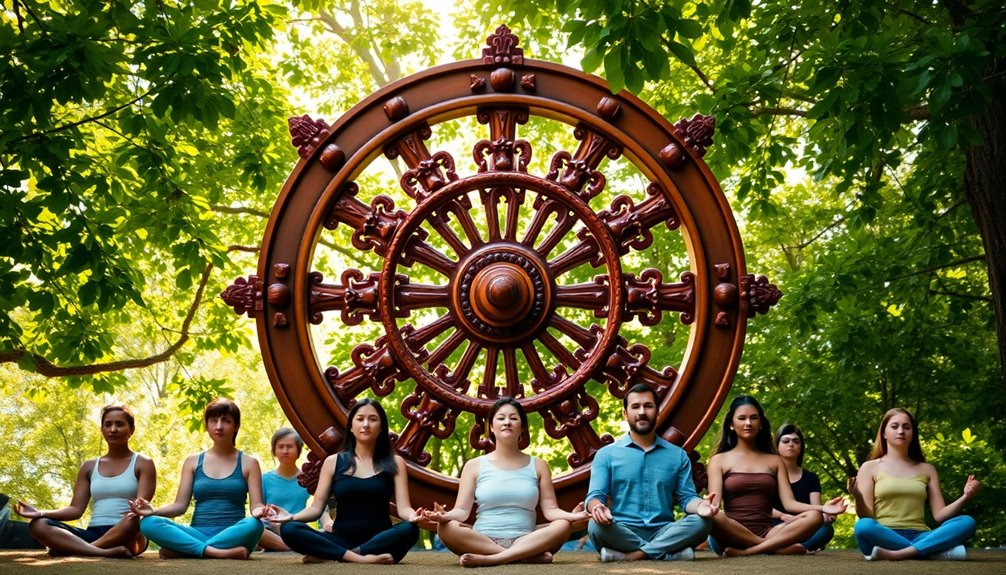The Dharma Wheel, a powerful symbol in Buddhism, plays a surprising role in modern life. You might find it featured in meditation practices, yoga studios, and wellness workshops, where it serves as a reminder of the Noble Eightfold Path. Its circular shape symbolizes the cyclical nature of life and promotes reflection for personal growth. Today, you'll spot it in jewelry and home decor, enhancing mindfulness and spiritual awareness. Even global events celebrating peace incorporate this ancient symbol. If you're curious about how it's adapted in various cultures, you'll uncover even more fascinating insights ahead.
Key Takeaways
- The Dharma Wheel is incorporated into mindfulness apps, enhancing meditation practices and promoting ethical living among users.
- It appears in contemporary jewelry and home decor, symbolizing a connection to Buddhist principles and encouraging spiritual growth.
- The symbol is featured in wellness workshops, emphasizing discipline and mindfulness as tools for personal development and goal achievement.
- Artistic representations, including street art and fashion, utilize the Dharma Wheel to promote messages of peace, community, and mindfulness.
- The Ashoka Chakra, inspired by the Dharma Wheel, plays a significant role in India's national identity, symbolizing justice and compassion in modern society.
Historical Significance of the Dharma Wheel

When you explore the historical significance of the Dharma Wheel, or Dharmachakra, you'll find it's far more than just a symbol; it's a cornerstone of Buddhist heritage. Dating back to the Mauryan period, this ancient Buddhist symbol first appeared on pillars erected by Emperor Ashoka around the 3rd century BCE. The Dharma Wheel encapsulates the teachings of Buddhism, particularly the Noble Eightfold Path and the Four Noble Truths, guiding practitioners on their journey toward enlightenment.
Archaeological discoveries, such as the Sanchi Stupa and Bharhut reliefs, highlight the early adoption of the Dharma Wheel in Buddhist iconography. These findings reveal its vital role in promoting Buddhist morality and nonviolence, making it a beacon of ethical conduct that transcends time.
Today, the Dharma Wheel's cultural relevance persists, exemplified by its inclusion in India's national flag as the Ashoka Chakra. This connection underscores the ongoing influence of Buddhist values on modern Indian identity and governance.
Symbolism in Buddhist Teachings

The Dharma Wheel isn't just a symbol; it represents your spiritual journey toward enlightenment.
Each part of the wheel highlights key aspects of Buddhist teachings, guiding you on the Noble Eightfold Path.
Today, it also serves as a cultural emblem, connecting communities and practices across the globe.
Spiritual Progression Significance
Understanding the significance of the Dharma Wheel in Buddhism reveals the profound depth of spiritual progression within the tradition. This wheel, with its circular shape, symbolizes the perfection of the Dharma and the continuous journey toward enlightenment. Each of the eight spokes represents the Noble Eightfold Path, guiding you through ethical conduct and mental development essential for liberation from suffering.
Here's a concise breakdown of the components of the Dharma Wheel:
| Component | Symbolism | Importance |
|---|---|---|
| Hub | Discipline and mental stability | Essential for effective meditation |
| Eight Spokes | Noble Eightfold Path | Guides practitioners in their journey |
| Circular Shape | Perfection of Dharma | Represents the cyclical nature of life |
The act of "turning the Dharma Wheel" signifies the dissemination of the Buddha's teachings, marking key moments in spiritual progression, such as his first sermon at Deer Park. This symbolism extends beyond individual practice, representing the collective advancement of Buddhist communities as they endeavor to embody wisdom, ethics, and mindfulness in their lives.
Cultural Symbolism Today
Cultural symbolism today breathes new life into the Dharma Wheel, or Dharmachakra, as it stands as a cornerstone of Buddhist teachings. This powerful Dharma Wheel (Dharmachakra) symbol represents not only the teachings of the Buddha but also the path to spiritual growth through the Noble Eightfold Path.
In contemporary contexts, you'll often find the Dharma Wheel featured in art, jewelry, and home decor, attracting positive energies and fostering mindfulness in everyday life.
The Ashoka Chakra, a prominent depiction of the Dharma Wheel, appears on India's national flag, highlighting its cultural significance and the historical spread of Buddhism in the region. Its presence serves as a reminder of the values of peace and harmony that Buddhism promotes.
Furthermore, the Dharma Wheel plays an essential role in meditation practices today, acting as a visual aid that helps you connect with the deeper meanings of Buddha's teachings and the cyclical nature of existence.
Various Buddhist communities around the globe incorporate the Dharma Wheel into rituals and celebrations, fostering unity and shared understanding of Buddhist principles across diverse cultures.
The Noble Eightfold Path Explained
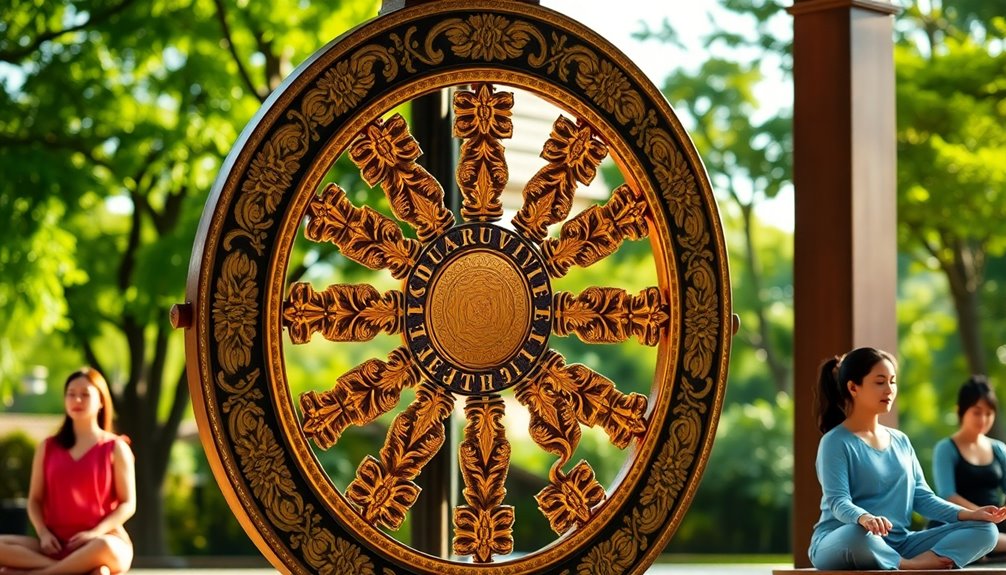
Buddhism's Noble Eightfold Path offers a practical framework for ethical living and mental development, guiding you toward enlightenment and liberation from suffering. This path consists of eight interconnected principles that foster wisdom, ethical behavior, and mental discipline.
| Principle | Description | Outcome |
|---|---|---|
| Right View | Understanding reality and truth | Clarity in perception |
| Right Intention | Commitment to ethical self-improvement | Positive mental states |
| Right Speech | Communicating truthfully and harmoniously | Harmonious relationships |
Practicing the Noble Eightfold Path helps you overcome ignorance and achieve Nirvana. Each principle, like the spokes of the Wheel of Dharma, supports one another, creating a balanced approach to spiritual growth.
| Right Action | Engaging in ethical conduct | Non-harmful behavior |
|---|---|---|
| Right Livelihood | Earning a living without causing harm | Sustainable means of support |
| Right Mindfulness | Awareness of body, feelings, thoughts | Enhanced presence in the moment |
As you embrace these teachings, you'll find that they not only guide your actions but also enrich your understanding of yourself and the world around you.
Cultural Representations and Variations

Throughout history, the Dharma Wheel has consistently served as a powerful symbol of Buddhist teachings across various cultures. Known as the Dharmachakra, this eight-spoked wheel represents the Noble Eightfold Path, guiding practitioners toward enlightenment.
You'll find the Dharma Wheel prominently featured in Buddhist art and architecture throughout Asia, often accompanied by the lotus flower and deer, which enhance its cultural significance.
In contemporary Buddhism, the Dharma Wheel plays a central role in rituals and meditation practices, serving as a reminder of spiritual growth. Its influence extends beyond traditional contexts, as modern adaptations appear in jewelry, home decor, and tattoos, allowing individuals to express their connection to Buddhist principles in everyday life.
The Dhammacakka flag in Thailand further highlights the Dharma Wheel's unifying role within Buddhist communities worldwide. This symbol not only embodies the moral and ethical framework of Buddhism but also resonates with those seeking mindfulness and personal development.
The Ashoka Chakra Connection
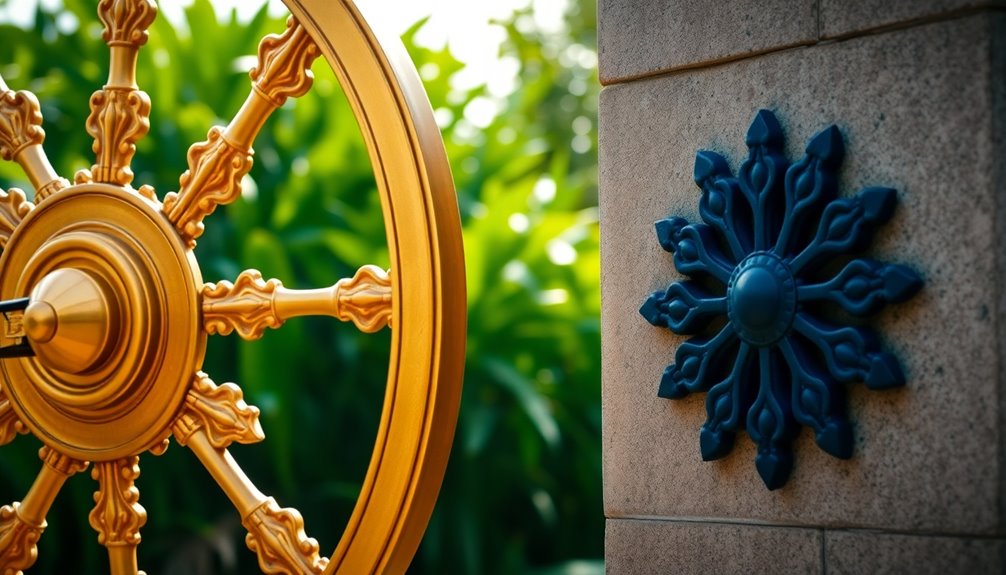
You can't overlook the Ashoka Chakra's historical significance in shaping Indian culture and governance.
It connects back to Emperor Ashoka, who championed Buddhist values through his edicts and monuments.
Today, the Chakra continues to symbolize peace and righteousness, reflecting its enduring impact on modern India.
Historical Significance of Ashoka
The Ashoka Chakra serves as a powerful symbol of the historical significance of Emperor Ashoka and his profound impact on Buddhism. Ruling from 304 to 232 B.C.E., Ashoka transformed the landscape of his empire by promoting Buddhist teachings. He erected pillars that featured edicts advocating for moral conduct, nonviolence, and the principles of Dharma.
These pillars, often crowned with the Ashoka Chakra, represent his commitment to peace and justice, reflecting his deep conversion to Buddhism. Historical artifacts like the Sanchi Stupa and the Bharhut sandstone reliefs highlight the importance of the Ashoka Chakra in early Buddhist art and architecture. They serve as tangible evidence of Ashoka's influence and the spread of his ideals throughout the region.
The Ashoka Chakra not only symbolizes the moral and ethical framework of Buddhism but also embodies the essence of Ashoka's reign, which focused on benevolent governance and the welfare of his subjects. This connection between Ashoka and the Dharma Wheel illustrates how a single ruler can leave a lasting legacy that shapes a nation's identity, fostering a deep-rooted appreciation for peace and justice in society.
Symbolism in Modern India
India's national identity is deeply intertwined with the Ashoka Chakra, a potent symbol of justice and righteousness. This 24-spoke dharmachakra appears prominently on the national flag, representing the eternal wheel of law. Adopted in 1947, the Ashoka Chakra reflects Emperor Ashoka's commitment to Buddhist principles and nonviolence, echoing his efforts to spread Buddha's teachings across his vast empire.
Emperor Ashoka's edicts, inscribed on stone pillars throughout India, often feature the dharmachakra, reinforcing its significance in promoting moral and ethical governance.
Today, the Ashoka Chakra serves as a reminder of India's rich cultural heritage and its historical ties to Buddhism, fostering unity among its diverse population.
In contemporary India, you'll see the Ashoka Chakra used in various government insignias and emblems, further embedding this Buddhist symbol into the nation's cultural landscape. Additionally, the principles of nonviolence and compassion advocated by Ashoka resonate deeply with modern movements for social justice and equality. This connection to the dharmachakra not only honors India's past but also inspires a vision of justice and righteousness for its future. By embracing this symbol, you participate in a shared identity that celebrates both the essence of Indian culture and the enduring values of compassion, integrity, and peace.
Modern Applications in Mindfulness

Many mindfulness practitioners today embrace the Dharma Wheel as a powerful symbol that enhances their meditation experience. This emblem serves as a visual reminder of the Noble Eightfold Path, helping you focus on its principles during your mindfulness sessions.
When you meditate, the Dharma Wheel encourages you to reflect on your thoughts and behaviors, fostering a deeper understanding of your journey toward spiritual growth.
Incorporating the Dharma Wheel into your practice can lead to personal transformation. You might find it featured in mindfulness apps and resources, illustrating the cyclical nature of life and urging you to maintain awareness.
Many yoga studios also utilize this symbol in their branding and decor, promoting balance and ethics among practitioners.
Wellness workshops and retreats increasingly highlight the Dharma Wheel, emphasizing the importance of discipline and mindfulness in achieving your goals.
Art depicting the Dharma Wheel often fills mindfulness spaces, evoking a sense of peace and encouraging you to connect with your inner self during meditation.
Artistic Representations in Contemporary Culture
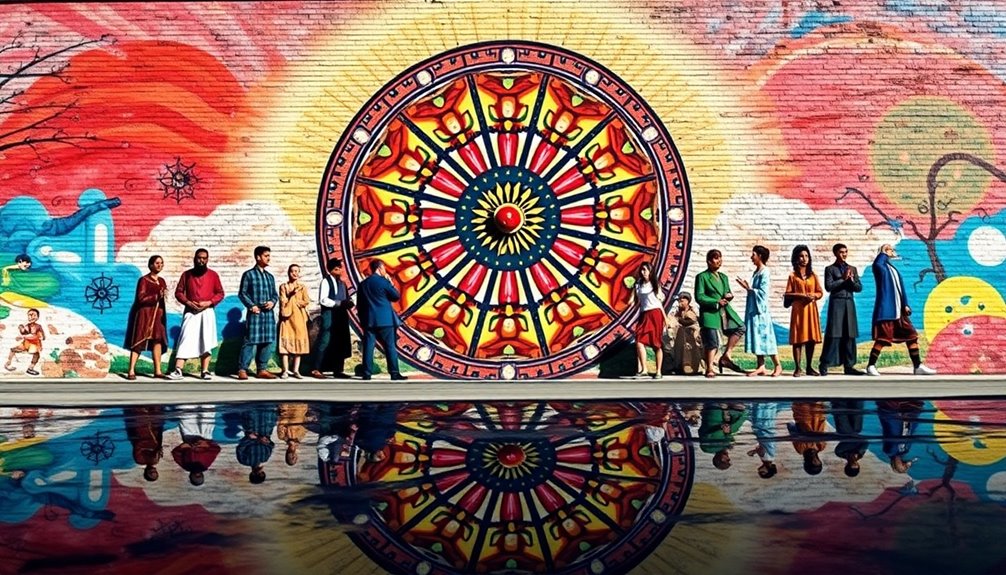
As artists draw inspiration from the Dharma Wheel, you can see its influence permeating contemporary culture through diverse mediums. This ancient symbol represents spiritual growth and enlightenment, and its artistic representations have found a home in various forms of expression today.
- Paintings and sculptures often showcase the Dharma Wheel, celebrating its significance in mindfulness practices.
- Jewelry designs frequently feature the Dharma Wheel, crafted from materials like silver or gold, serving as a personal reminder of Buddhist teachings.
- Graphic design and digital art utilize the Dharma Wheel in promotional materials for wellness workshops, highlighting its role in modern spirituality.
- Street art and murals depict the Dharma Wheel, conveying messages of peace and community, affirming its relevance in public consciousness.
- Fashion brands incorporate the Dharma Wheel motif, aligning their products with themes of mindfulness and spiritual exploration in contemporary consumer culture.
Through these artistic expressions, the Dharma Wheel continues to inspire and resonate, serving as a bridge between ancient wisdom and modern life.
Turning the Dharma Wheel Today
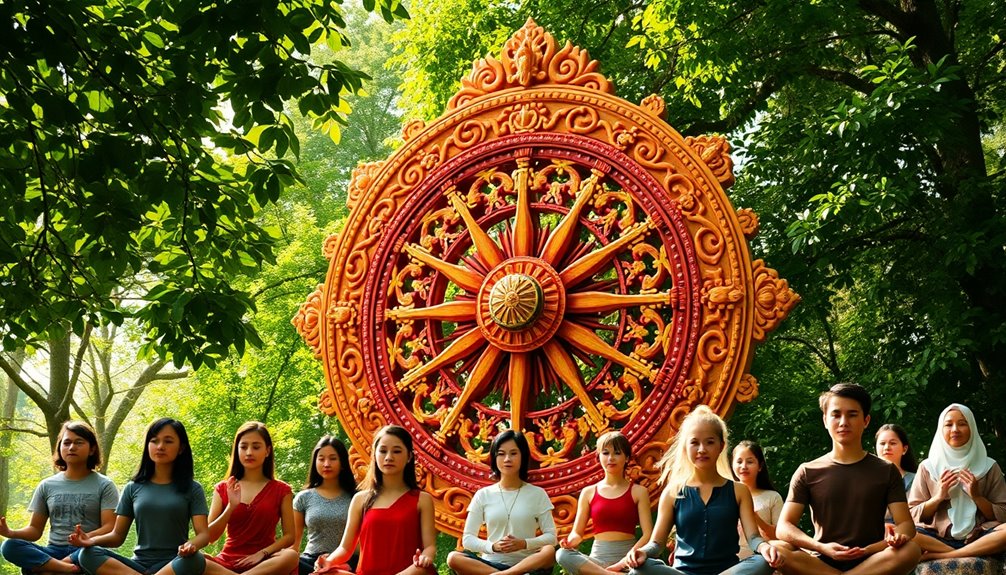
Turning the Dharma Wheel today means embracing its teachings in our daily lives, as this ancient symbol continues to guide individuals on their paths to enlightenment.
In modern practices, you'll find the Dharma Wheel represented in mindfulness sessions and wellness retreats, where it serves as a powerful visual reminder of your journey towards personal growth and spiritual understanding.
Buddhist communities actively incorporate the Dharma Wheel into their logos and promotional materials, showcasing their commitment to spreading the teachings of the Buddha in contemporary society.
Significantly, the Ashoka Chakra, a modern interpretation of the Dharma Wheel, graces India's national flag, symbolizing the ongoing relevance of Buddhist principles in governance and culture.
You might also encounter the Dharma Wheel in various forms of art and jewelry.
These representations promote values such as peace, harmony, and spiritual progress, appealing to those seeking a deeper connection to Buddhist teachings.
Spiritual Growth and Personal Development

By incorporating the Dharma Wheel into your daily routine, you can enhance your mindfulness and meditation practices.
This symbol not only serves as a reminder of the Noble Eightfold Path but also encourages deeper self-reflection.
As you engage with its teachings, you'll find opportunities for spiritual growth and personal development.
Mindfulness Through Symbols
Symbols like the Dharma Wheel serve as powerful tools for mindfulness, enhancing your spiritual growth and personal development. This symbol not only represents the Buddhist path but also acts as a visual reminder of the Four Noble Truths. By incorporating the Dharma Wheel into your daily life, you can cultivate a deeper sense of mindfulness and clarity.
- Daily Reflection: Use the Dharma Wheel to prompt self-awareness regarding your actions and thoughts.
- Mindful Art: Surround yourself with art featuring the Dharma Wheel to inspire positive energies.
- Meditation Focus: Contemplate the symbolism during meditation to deepen your understanding of the Buddhist path.
- Purposeful Living: Let the Wheel guide you towards ethical living and liberation from samsara.
- Personal Growth: Embrace the cyclical nature of life as a means for continuous spiritual progression.
- Transformative Approach: Incorporating the Dharma Wheel in your practice can lead to positive thinking, enriching your overall well-being and resilience.
Enhancing Meditation Practices
Enhancing your meditation practices can considerably deepen your spiritual growth and personal development. The Dharma Wheel, symbolizing the Noble Eightfold Path, serves as an excellent focal point during your meditation sessions.
By incorporating the imagery of the Dharma Wheel in your meditation space, you remind yourself of the cyclical nature of existence, which emphasizes continuous self-improvement and mindfulness.
Modern mindfulness apps and workshops frequently utilize the Dharma Wheel, helping you structure your practice around its teachings. This approach supports holistic personal development by fostering discipline and concentration—key components for achieving deeper states of awareness.
As you meditate, focus on the spokes of the Dharma Wheel. Each spoke represents an aspect of the Eightfold Path, guiding you through a structured reflection on your spiritual journey.
This intentional practice not only enhances your meditation experience but also cultivates the ethical conduct and mental clarity essential for your growth.
The Dharma Wheel in Global Contexts
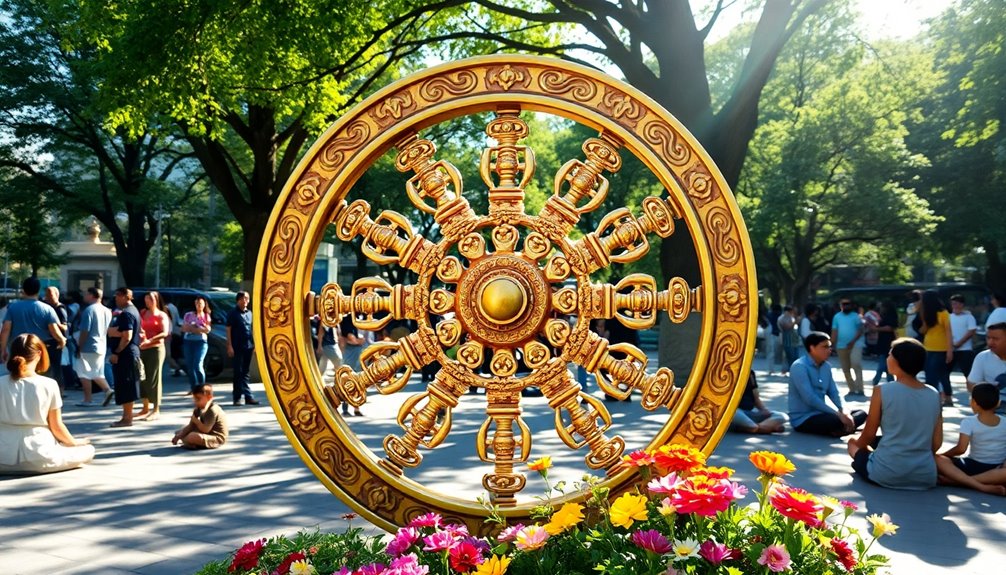
The Dharma Wheel, or Dharmachakra, serves as a powerful symbol of Buddhism that transcends regional boundaries, reflecting the religion's profound influence worldwide. Its historical significance and representation of the Buddha's teachings resonate across cultures, reaching far beyond traditional Buddhist countries.
- The Dharma Wheel features prominently in India's State Emblem and national flag, symbolizing non-violence and moral law.
- In Thailand, the Dhammacakka flag incorporates the Dharma Wheel, highlighting its importance in Thai culture.
- The Ashoka Chakra, derived from the Dharma Wheel, serves as an insignia for Buddhist chaplains in the U.S. Armed Forces, demonstrating its integration into diverse contexts.
- Museums in India, Japan, and China showcase dharmachakras, emphasizing their archaeological value and the historical dissemination of Buddhist teachings.
- Today, the dharmachakra appears in contemporary jewelry and home decor, symbolizing spiritual growth and mindfulness for those seeking a connection to Buddhist principles.
In this way, the Dharma Wheel continues to inspire individuals globally, embodying the essence of Buddhist symbols while encouraging spiritual growth and understanding across various cultures.
Frequently Asked Questions
How Is the Dharma Wheel Used in Buddhism?
The Dharma Wheel is integral to Buddhism, representing the teachings of the Buddha and guiding your spiritual journey.
You'll often see it in rituals and ceremonies, symbolizing key principles like the Noble Eightfold Path.
In meditation, it helps you focus on ethical conduct and mental development.
Additionally, the symbol appears in various cultural expressions, uniting Buddhist communities worldwide in their shared commitment to the teachings and practices of Buddhism.
What Does the Wheel Symbol Mean in Buddhism?
Imagine a wheel rolling smoothly along a path; that's the essence of the Dharma Wheel in Buddhism. It symbolizes the teachings of Buddha and the journey toward enlightenment.
The wheel's hub represents moral discipline, while its eight spokes embody the Noble Eightfold Path, guiding you through right actions and thoughts.
Its circular shape reflects life's cyclical nature, reminding you of the interconnectedness of all existence and the importance of following the path to liberation.
What Is an Important Symbol in Buddhism That Represent the Dharma?
An important symbol in Buddhism that represents the dharma is the Dharma Wheel, or Dharmachakra.
When you observe its eight spokes, you'll see they guide you along the Noble Eightfold Path, leading you toward enlightenment.
The wheel's circular shape emphasizes life's cyclical nature, while the hub signifies the discipline needed for meditation.
This symbol encapsulates the essence of Buddhist teachings, reminding you of the importance of mental stability and spiritual growth on your journey.
Why Is the Wheel of Life Important to Buddhism?
Did you know that over 90% of Buddhists worldwide see the Wheel of Life as a core teaching?
The Wheel of Life is essential to Buddhism because it visually represents the cycle of samsara, illustrating the interconnectedness of birth, death, and rebirth.
It highlights the Three Poisons that lead to suffering and shows the six domains of existence.
Understanding it helps you grasp the nature of suffering and the path to liberation through spiritual practice.
Conclusion
As you explore the dharma wheel's significance today, think of it like a compass guiding you through life's complexities. Just as a traveler relies on their compass to navigate unfamiliar terrain, you can use the teachings represented by the wheel to find your path in a chaotic world. Whether you're seeking personal growth or deeper understanding, the dharma wheel remains a timeless symbol, reminding us that every turn we take can lead to enlightenment and connection.
